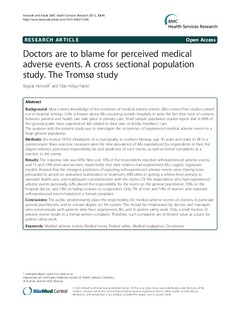| dc.contributor.author | Hotvedt, Ragnar | |
| dc.contributor.author | Førde, Olav Helge | |
| dc.date.accessioned | 2017-06-07T12:41:11Z | |
| dc.date.available | 2017-06-07T12:41:11Z | |
| dc.date.issued | 2013 | |
| dc.identifier.citation | Hotvedt, R. og Førde, O.H. (2013) Doctors are to blame for perceived medical adverse events: a cross sectional population study. The Tromsø study. BMC health services research, 13(46). | |
| dc.identifier.uri | http://hdl.handle.net/11250/2445209 | |
| dc.description | Beskriver en survey hvor hensikten var å undersøke forekomst av legemiddelbivirkninger i en stor generell populasjon. | |
| dc.description.abstract | Background: Most current knowledge of the incidence of medical adverse events (AEs) comes from studies carried out in hospital settings. Little is known about AEs occurring outside hospitals, in spite the fact that most of contacts between patients and health care take place in primary care. Small sample population studies report that 4-49% of the general public have experienced AEs related to their own or family members´ care. The purpose with the present study was to investigate the occurrence of experienced medical adverse events in a large general population. Methods: We invited 19763 inhabitants of a municipality in northern Norway, age 30 years and older, to fill in a questionnaire. Main outcome measures were life time prevalence of AEs experienced by respondents or their first degree relatives, perceived responsibility for and predictors of such events, as well as formal complaints as a reaction to the events. Results: The response rate was 66%. Nine and 10% of the respondents reported self-experienced adverse events, and 15 and 19% (men and women, respectively) that their relatives had experienced AEs. Logistic regression models showed that the strongest predictors of reporting self-experienced adverse events were: Having been persuaded to accept an unwanted examination or treatment, difficulties in getting a referral from primary to specialist health care, and inadequate communication with the doctor. Of the respondents who had experienced adverse events personally, 62% placed the responsibility for the event on the general practitioner, 39% on the hospital doctor, and 19% on failing routines or cooperation. Only 7% of men and 14% of women who reported self-experienced events handed in a formal complaint. Conclusions: The public predominantly place the responsibility for medical adverse events on doctors, in particular general practitioners, and to a lesser degree on the system. This should be emphasised by doctors and managers who communicate with patients who have experienced AEs, and in patient safety work. Only a small fraction of adverse events results in a formal written complaint. Therefore, such complaints are of limited value as a basis for patient safety work. | |
| dc.language.iso | eng | |
| dc.rights | Navngivelse 4.0 Internasjonal | |
| dc.rights.uri | http://creativecommons.org/licenses/by/4.0/deed.no | |
| dc.subject | pasientsikkerhet | |
| dc.subject | legemiddel | |
| dc.subject | legemiddelbruk | |
| dc.subject | legemiddelbehandling | |
| dc.subject | legemiddelrelaterte problemer | |
| dc.subject | bivirkninger | |
| dc.subject | uønskede hendelser | |
| dc.subject | forekomst | |
| dc.subject | spørreundersøkelse | |
| dc.subject | survey | |
| dc.subject | tverrsnittstudie | |
| dc.subject | Tromsø | |
| dc.subject | Norge | |
| dc.title | Doctors are to blame for perceived medical adverse events. A cross sectional population study. The Tromsø study | |
| dc.type | Journal article | |
| dc.rights.holder | Hotvedt, Ragnar | |
| dc.source.volume | 13 | |
| dc.source.journal | BMC Health Services Research | |
| dc.source.issue | 46 | |
| dc.identifier.doi | 10.1186/1472-6963-13-46 | |

